
The economic sanctions against Russia and Belarus also apply to traffic transiting through these countries, meaning that an increasing share of rail freight is beginning to shift to the emerging Eurasian Middle Corridor. Its route enters the European continent from China, via Kazakhstan, through the Caspian Sea and the South Caucasus, Türkiye or the Black Sea. This transport corridor is also known as the Trans-Caspian route because of the section crossing the Caspian Sea.
The agreement on the Trans-Caspian International Transport Route (TITR) (Middle Corridor for short) was signed in Astana in 2013 by the Kazakh, Azeri and Georgian state-owned railway companies, the port authorities of Baku in Azerbaijan, Aktau in Kazakhstan, Batumi in Georgia and the Azeri state shipping company. The organisation has been operational since 2017 and has since been joined by the Turkish and Ukrainian railways, as well as several transport/logistics companies from countries along the route.
The Trans-Caspian section of the route runs from the Kazakh port of Aktau to Baku in Azerbaijan and the new Azeri cargo port of Alat to the south. To develop the transit transport of goods across the Caspian Sea, the countries around the sea have made very significant investments in infrastructure. Kazakhstan has implemented extensive developments in the port of Aktau, Turkmenistan has built an almost entirely new port in Türkmenbasy, and Astara, Iran's new port, was built on the border of Iran and Azerbaijan. Given that the largest port on the Caspian Sea, Baku in Azerbaijan, is essentially in the city itself and there was no more space for further port expansion, Azerbaijan built a new port south of Baku, in Alyat.
At the same time, the biggest barrier to cargo traffic through the Caspian Sea is that only one shipping company, Azerbaijan’s ASCO, carries freight, and only at relatively high cost and for relatively long periods. Further developments in the near future are indicated by the agreement between the Azeri and Turkmen governments in January 2022 to establish a regular ferry service between Türkmenbasy and Baku, with two ferries scheduled to operate weekly. This is also important because it is the shortest route across the Caspian Sea, but at the same time, it is dependent on the construction of a rail connection in Turkmenistan.
The most important eastern country for freight transport on the Black Sea is Georgia, which has 310 km of Black Sea coastline. In addition to Batumi, the country's largest port, the port of Poti, has also been significantly developed in recent years. A regular weekly ferry service between Georgia's two largest ports of Batumi/Poti and the Romanian port of Constanta started this summer. As shown on the map illustrating the Trans-Caspian Route, there are three main transport directions from Georgian ports: to the Turkish port of Istanbul, the Romanian port of Constanta mentioned above, and the Ukrainian ports of Odessa and Chornomorsk to the south. Moreover, since the outbreak of the war, the transport of goods across the Black Sea has increased significantly.

Freight transport via the Middle Corridor is still a fraction of what it used to be via Russia and Belarus, with a capacity currently equivalent to only 5 per cent of the main Eurasian Northern transport route. At the same time, on account of the war, the demand and the need for the substantial development and use of the middle route by carriers is increasing. Traffic on the route is projected to grow to 3.2 million tonnes in 2022, a six-fold increase compared to 2021. This is also due to the launch in May 2022 of the first full-length container train from Chungking in China to Central Europe via Kazakhstan, Azerbaijan, Georgia and Romania, by Finnish company Nurminen Logistics in cooperation with the Chinese and Kazakh railways.
As this rail route is three times faster than sea transport, and there are a lot of products in warehouses that have not been shipped since the war began, the company plans to run weekly containerised rail services. Another step forward is the massive development of Kazakhstan's rail and logistics infrastructure to better connect the country's Caspian coastline with its inland rail network.
There are also efforts being made by the European Union to develop this central transport corridor, ensuring the continuity of freight transport between China and the EU. The other stakeholder is China, as currently the only land route for China to reach the European market is via this route. It remains to be seen what new transport and logistics investments China will launch in the near future in the countries along the route.
At the same time, further massive infrastructure development of the Middle Corridor will take at least a decade (but probably several decades) and rail freight between China and Europe is likely to decline dramatically in the years ahead (at least until the war is over), as there is simply no land transport route through which Chinese goods can reach European markets relatively quickly and at reasonable cost. This is expected to lead to a further significant increase in traffic on the 21st Century Maritime Silk Road, and in particular at its main European entry point, the port of Piraeus.